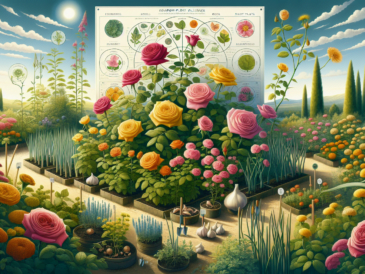The principles of Organic Gardening
Organic gardening is a little bit different from traditional gardening methods. It is a holistic approach that emphasizes building healthy soils, promoting biodiversity, and avoiding the use of synthetic fertilizers and pesticides. The principles of organic gardening involve creating a natural ecosystem that fosters healthy plant growth and vitality.
Benefits of organic gardening
One of the greatest benefits of organic gardening is the production of nutritious, chemical-free fruits and vegetables. By avoiding the use of synthetic chemicals, organic gardeners can ensure that the food they grow is safe for consumption and free from harmful residues. Additionally, organic gardening promotes environmental sustainability by reducing pollution and conserving natural resources.
Creating Healthy Soils
The foundation of organic gardening lies in creating and maintaining healthy soils. Organic gardeners focus on building soil fertility through the use of compost, cover crops, and natural fertilizers. These practices help to enhance soil structure while providing essential nutrients for plant growth. By nurturing healthy soils, organic gardeners enable plants to better resist pests and diseases.
Promoting Biodiversity
Organic gardening also places a strong emphasis on promoting biodiversity within the garden ecosystem. This involves encouraging a wide variety of plants, insects, and wildlife to coexist harmoniously. By fostering diversity, organic gardeners can create a balanced environment that naturally controls pests and diseases while supporting beneficial organisms such as pollinators.
Avoiding Synthetic Chemicals
In contrast to conventional gardening, organic gardening avoids the use of synthetic fertilizers and pesticides. Instead, organic gardeners employ natural alternatives such as neem oil, insecticidal soaps, and biological controls to manage pests and diseases. By eliminating synthetic chemicals, organic gardeners protect the health of their plants, wildlife, and the surrounding environment.
In conclusion,
Organic gardening encompasses a set of principles that prioritize natural solutions over artificial interventions. By focusing on soil health, biodiversity, and environmental stewardship, organic gardeners can create productive gardens that are in harmony with nature.
The Benefits of Organic Growing for Plants and the Environment
Organic growing offers numerous advantages for both plants and the environment. By using natural methods and avoiding synthetic chemicals, organic growing can lead to healthier plants and a more sustainable ecosystem.
Nutrient-Rich Soil
One of the major benefits of organic growing is its ability to promote nutrient-rich soil. Through the use of compost, cover crops, and natural fertilizers, organic farmers enrich the soil with essential minerals and nutrients. This results in healthier plants with improved resistance to pests and diseases.
Environmental Impact
Organic growing practices also have a positive impact on the environment. By avoiding the use of harmful pesticides and synthetic fertilizers, organic farmers help protect local ecosystems and reduce air and water pollution. Additionally, organic farming techniques contribute to enhanced biodiversity and soil conservation, leading to a more balanced and sustainable environment.
Improved Taste and Nutrition
Another advantage of organic growing is the enhanced taste and nutritional value of produce. Studies have shown that organic fruits and vegetables often contain higher levels of essential nutrients such as vitamins, minerals, and antioxidants, providing consumers with healthier food options.
Overall, organic growing offers a holistic approach to farming that benefits not only plants but also the broader environment. By prioritizing natural methods and sustainable practices, organic growers play a crucial role in promoting healthy ecosystems and providing consumers with high-quality, nutritious food options.
When it comes to cultivating healthy plants, the significance of soil health cannot be overstated. The condition of the soil directly impacts the growth and development of plants, making it crucial to prioritize soil preparation.
Importance of Soil Health for Plant Growth
A key factor in plant growth is the overall health of the soil in which they are planted. Healthy soil provides essential nutrients and a suitable environment for plant roots to thrive, leading to improved crop yields and overall plant vigor.
Techniques for Improving Soil Fertility and Structure
A little effort and care can go a long way in enhancing soil fertility and structure. Implementing practices such as crop rotation, cover cropping, and mulching can aid in maintaining a balanced nutrient content in the soil while promoting its structural integrity.
Composting and Organic Fertilizers
Incorporating composting and organic fertilizers into soil preparation serves as a sustainable approach to enriching the soil with essential nutrients. This not only fosters healthier plant growth but also contributes to the overall well-being of the environment by reducing chemical inputs.
A. Selecting the right plants for your garden
When cultivating an organic garden, it’s vital to choose suitable plants that thrive in the prevailing environmental conditions. Research a little to gather information about which plants are best for your region so they can flourish without much struggle. Consider factors such as sunlight, water requirements, and soil type to make the most suitable selections. By selecting plants that are well-suited to your area, you’ll set yourself up for a thriving organic garden experience.
B. Proper planting techniques for different types of plants
When planting vegetables and herbs, ensure that you gently loosen the soil and mix in some organic compost before planting the seeds or transplants. This helps create a conducive environment for root development and plant growth. Remember to provide adequate water and minimize the use of chemicals to maintain the natural integrity of your produce.
2. Flowers and Ornamental Plants
For flowers and ornamental plants, pay attention to their individual needs when it comes to planting techniques. Some may require specific soil conditions or spacing, while others may need special care during planting to keep them healthy and blooming beautifully. Taking a little extra time to understand each plant’s needs will contribute to a successful garden full of vibrant colors.
C. Crop rotation for maintaining soil health and preventing disease
Crop rotation is an essential practice in organic growing that involves alternating the types of crops grown in specific areas seasonally. This little change plays a crucial role in maintaining soil health by replenishing nutrients used by previous plantings and preventing the buildup of pests and diseases associated with continuous cultivation of the same crop. A well-executed crop rotation plan ensures that your garden remains productive while minimizing the need for synthetic pesticides or fertilizers.
Natural Pest And Disease Management
Natural methods for tackling pests and diseases are a preferable alternative to chemical treatments. These methods work in harmony with the environment, using biological or physical measures to manage infestations. For example, introducing predator insects like ladybugs can help control aphid populations, while using neem oil can deter pests and fungal diseases.
Companion Planting for Pest Management
A clever technique used by organic growers is companion planting, which involves strategically planting different species together to naturally repel pests or attract beneficial insects. For instance, marigolds can be planted alongside tomatoes to deter nematodes, and basil can help to keep mosquitoes at bay in the garden.
Creating a Healthy Ecosystem
Another effective approach is to foster a healthy ecosystem within the garden that reduces the pressure from pests and diseases. This includes practices such as maintaining rich, organic soil with proper drainage, encouraging a diversity of plants and creating habitats for natural predators like birds and amphibians.
When it comes to organic growing, extending the growing season can be a game-changer for your garden. Techniques like using row covers, cold frames, and hoop houses can help you keep your plants thriving even as the temperatures drop. These methods provide a little extra insulation and protection from frost, allowing you to start planting earlier in the spring and harvest later into the fall.
Building and maintaining a greenhouse for plant growth
If you’re serious about maximizing your yield and protecting your plants from harsh weather conditions, building a greenhouse is the way to go. Greenhouses create a controlled environment that shields your plants from extreme heat, cold, wind, and pests. To ensure that your greenhouse continues to support healthy plant growth, it’s important to maintain proper ventilation, temperature control, and pest management inside the structure.
Maximizing plant growth in a greenhouse environment
Once you’ve got your greenhouse set up, it’s time to focus on getting the most out of your space. Pay attention to factors like light exposure, humidity levels, soil health, and nutrient balance to keep your plants thriving. Consider installing automated irrigation systems to make sure your plants are getting just the right amount of water without any hassle. With the right techniques in place, your greenhouse can become a powerhouse for producing healthy, vibrant crops all year round.
Proper Techniques for Harvesting Different Types of Plants
When it comes to harvesting different types of plants, it’s important to use the proper techniques to ensure that the crops are gathered at their peak. For example, for leafy greens like lettuce and spinach, it’s best to harvest in the early morning when the leaves are crisp and full of moisture. This helps to preserve their flavor and texture.
On the other hand, root vegetables such as carrots and potatoes should be harvested when the soil is dry to prevent them from rotting. By paying attention to these little details, you can maximize the quality and yield of your harvest.
Storing and Preserving Harvested Crops
After harvesting, it’s crucial to store and preserve your crops properly to maintain their freshness and flavor. One common mistake is storing fruits and vegetables together, as they release different gases that can cause spoilage. It’s also essential to remove any damaged or bruised produce before storage, as these areas can quickly degrade and affect neighboring items. Additionally, utilizing proper storage containers and keeping the temperature and humidity levels in check are essential steps in preserving your hard-earned harvest.
Maximizing the Shelf Life of Harvested Produce
Once your produce is stored, maximizing its shelf life becomes a priority. One simple but effective method is to maintain regular inspections of stored crops, removing any items that show signs of spoilage or decay. Another key factor in extending shelf life is proper ventilation, which can help prevent mold growth and maintain optimal conditions for longevity. Lastly, consider utilizing preservation techniques such as canning, drying, or pickling to extend the shelf life of your bounty well beyond its natural expiration date.
Strategies for marketing and selling organic produce
When it comes to marketing and selling organic produce, there’s a myriad of strategies that can be employed. Online platforms such as social media and e-commerce websites offer a flexible and cost-effective way to reach potential customers. Developing relationships with local markets, restaurants, and co-operatives can also be a fruitful approach.
Building relationships with customers and local markets
Ongoing communication with customers is vital for building strong relationships. This could involve regular updates on available produce, special promotions, or even recipes and tips for using organic products. Establishing rapport with local markets and businesses can lead to collaborative efforts in promoting organic products through events like farmer’s markets or community workshops.
Maintaining the quality and freshness of organic produce for sale
To ensure the ongoing success of selling organic produce, maintaining quality and freshness are non-negotiable. Practices such as proper storage, efficient transportation, and using eco-friendly packaging materials can all contribute to preserving the integrity of organic produce from farm to table. Regular monitoring of inventory turnover and minimizing waste also play a vital role in sustaining the freshness of organic offerings.

